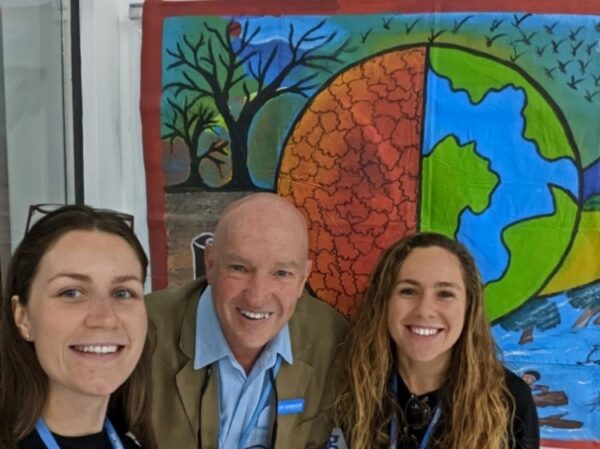By Nerea Ferrando Jorge

A photograph of me taken by Dannielle Roche with the COP27 sign at the conference center
How was COP? This is the big question I was dreading to answer upon my return from the 27th UN Climate Change Conference. My friends, family and work colleagues were eager to find out what it was like to be at the center of climate negotiations. I could sense the excitement in their voices, and I struggled to convey a message of hope. In the back of my mind, I had the same frustrating thought: what are we still waiting for?
This was meant to be the year for climate action! COP27 was branded as the COP for “implementation.” So naturally, as an environmental scientist and PhD researcher working in the field, I wanted to be there, to experience history in the making. Sadly, in many ways, the outcomes of COP27 have been a disappointment. Upon my return, I took a bit of time off to digest the enormity of COP and reflect on my experience.
Ultimately, I would say that COP27 was a mixture of hope and despair. The conference space is huge! There are vast halls of pavilions, representing different countries and industries, where talks on all-things climate are given – sometimes even by global leaders. The atmosphere is fast paced. People are racing between events, speeches, press conferences, and even small protests. You have the chance to meet people from all corners of the world from diverse backgrounds: governors, ministers, youth activists, professors, researchers, engineers, artists. The list is never-ending. And the beauty of it all, during the two weeks, everyone is seemingly at the same level. I, myself, sat to chat with the Spanish delegation over coffee and ended up sharing lunch with government officials from Ecuador.

Own image, participants walking through the COP27 conference center
The energy and passion are palpable in the main venue. But the reality is that behind closed doors, another COP is hidden from the majority of participants. One which is slow, and tedious, with sleep deprived diplomats. I’m talking about the negotiation rooms. This is where battles over punctuation and words determine the fate of our planet. Phasing “down” vs. phasing “out”, or whether fossil fuels are even named at all.
What I’ve come to realize is that COPs are many things, but what they are not is the center or the culmination of climate action. A third of a century from the first IPCC report, atmospheric concentrations of carbon dioxide continue their inexorable rise, regardless of the 27 annual COP cycles, net-zero pledges, and carbon offsets. A year ago, at COP26 in Glasgow, governments agreed to “revisit” and “strengthen” their plans to slash emissions for this was meant to be the year of climate action. Since then, demands from environmental groups and scientists to leave oil and gas in the ground were put to the side, as European countries scrambled to replace Russian gas. 40 billion tons of carbon dioxide have been spewed into the atmosphere and the Paris-based IEA estimates emissions from fossil fuels in 2022 will be the highest in history.
Our emission trajectories commit us to further warming and higher risks. The earth has already warmed around 1.2°C above pre-industrial times and the latest report from leading experts at IPCC (Intergovernmental Panel on Climate Change) warns that we must limit global heating to 1.5°C degrees. Scientists reiterate that 1.5C° is a limit, not a target. Breaching 1.5°C degrees would condemn millions of people to extreme suffering and trigger climate tipping points. Yet, a series of UN reports has made it clear that there is “no credible pathway” to avoid surpassing this limit. In fact, we are on a pathway to exceed 1.5°C as soon as by the middle of the next decade, and with current commitments, we are headed for 2.4°C of warming by 2100.
This news should scare everyone! The impacts of climate change are already happening across the globe. Millions of people are already being displaced and lives are being lost due to devastating floods and extreme heatwaves and droughts. At COP, my colleague Dannielle Roche and I, interviewed the High Commissioner for the UNHCR, Andrew Harper. He explained that 70% of refugees are in some way, climate refugees.

Own image from interview with Andrew Harper along with Dannielle Roche
This year, protests at COP27 focused on compensation for climate change impacts. The plea for help from vulnerable nations was heart-breaking. I heard first-hand the minister of Pakistan speak emotively about how recent floods left one third of the country underwater and displaced nearly 8 million people. Young climate activists, such as Vanessa Nakate, also took the stage saying, “Climate change is more than statistics, it’s more than data points. It’s more than net-zero targets. It’s about the people, it’s about the people who are being impacted right now.” For this reason, achieving an agreement on a fund for loss and damage after three decades was a breakthrough. However, the difficult part comes next – the fund must be set up and filled with cash. There is no agreement yet on when this will begin, how the finance will be provided, or even who or how much will be paid. Industrialized countries have been extremely cautious and it sounds like it will be a slow and long process.
Nevertheless, despite some successes such as the loss and damage fund, the simple truth is that the final text proposed at COP27 is not a clear commitment to 1.5°C. Alok Sharma, the British politician who served as the President for COP26, was profoundly disappointed by the lack of ambition saying, “emissions peaking before 2025, as the science tells us is necessary. Not in this text. Clear follow-through on the phase down of coal. Not in this text. A clear commitment to phase out all fossil fuels. Not in this text. And the energy text, weakened, in the final minutes.”
Science shows there is no time to lose in lowering global emissions, yet political action keeps falling short. We must do better. Time after time COPs have failed to accomplish what science says we must do in order to address the climate emergency. So, our focus should be on what we do in the space between these negotiations.
The COVID pandemic has taught us that the impossible is possible, and that we can solve global problems by working together. Developing new vaccines typically takes 5 to 10 years but a joint response from across all sectors led to vaccines being approved only 9 months after the World Health Organization declared a pandemic. This demonstrates that there is still a fighting chance to keep the 1.5°C goal alive but we need everyone on board. This COP showed that most of the world’s governments are committed, energy trends show that’s in reach, and solutions across all sectors of the global economy are ready. It will take collaborations between academia, business, finance, governments and civil society, but it can be done.
Attending COP has pushed me to do better because ultimately, it will take many more voices to make a difference. I have not given up, and nor should YOU! Let’s not wait any longer. It’s time for action, not pledges!

